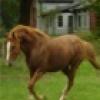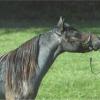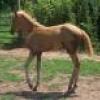Reverting to dun
Forums
Re: Reverting to dun
Well, they won't spontaneously start having dun foals just because they go feral. :lol: Genetic rules still apply. You may end up with more duns per population because of natural selection, the duns that are already there with survive better and reproduce. But you have to have some duns to start with, somehow. So in a way she is right (feral herds are likely to select for dun) but in a way wrong (non-duns will not have dun foals).
Horsegen or anyone, how likely is a mutation that reverts a color to wild type? Since dun is wild type in horses and other colors are mutations from it, I would think it would be very rare to mutate [i]to[/i] dun?
Re: Reverting to dun
[quote="Morgan"]But you have to have some duns to start with, somehow. So in a way she is right (feral herds are likely to select for dun) but in a way wrong (non-duns will not have dun foal)[/quote]
Hmmmm. [i]Why[/i] would feral herds select for dun?
I understand the sentiment that it has to be 'in there' in order to come out. But I am trying to understand why dun foal would have a better chance of survival vs a regular chestnut/bay/black :?
With that being said: I am a loyal vistor of BLM mustang sales (just to look at them) and interesting colors do happen. Roan and Dun certainly very present. But paints as well. And to me, a paint truly sticks out in a pasture. :o Yet maybe the broken colors of a paint make them blend?
Re: Reverting to dun
I dont think the BLM mustangs are being subjected to the kind of natural selection that would be needed to weed out the "sticking out" colored ones. Just look at the way ANY of them multiply, they are culled by humans, not things that have to sneak up on them :)
but in a ballanced feral environment with natural predators the dun ones have a better chance at survival. without predators it's just who doent starve or break a leg
Re: Reverting to dun
It wasn't a big discussion, but the OP on the thread said they had heard it and another more knowledgable person said it did happen. Seeing as feral horses don't tend to have the large predators that were around when original horses evolved I can't see even a tendency for it to happen. Thanks for the replies, I thought I might have got it wrong :?
Re: Reverting to dun
I do wonder if feral horses would have more dun like characteristics, such as countershading dorsals/shoulder bars/darker legs.
OT but I know domestic pigs if left to be feral actually start looking like wild boars;they get coarse thick hair,head starts to change slightly,get longer tusks. The change was simply amazing in just a few years.
Re: Reverting to dun
[quote="Morgan"]I dont think the BLM mustangs are being subjected to the kind of natural selection that would be needed to weed out the "sticking out" colored ones. Just look at the way ANY of them multiply, they are culled by humans, not things that have to sneak up on them :)
but in a ballanced feral environment with natural predators the dun ones have a better chance at survival. without predators it's just who doent starve or break a leg[/quote]
If BLM does not qualify as feral environment, I would not know where in the world would. :shock: Monglia? Prezewalski's? (those are already primitively marked, so that would not be any proof)
Re: Reverting to dun
Well, BLM horses are 'managed', water supplies provided, hay drops, predators are 'controlled' by ranchers...basically, I don't believe that there are sufficient stressors on feral horses' environments post-civilisation as there were pre-civilisation for natural selection to have as big a hand in things as it once might have.
Diane
Re: Reverting to dun
Cats quickly revert to Tabby base when left to go feral, and Black, of course, but I do think that is natural selection, the dominant Tom is Tabby, therefore most offspring are, and so on.
Dun and Bay are definitely the best colours for camouflage, but, again, it depends on the colour/pattern of the dominant stallion.
BLM mustangs , I feel, would have to be "guided" towards being Pinto, as these, surely, sell better than solids??
The indigenous (thought to be) pony we have here, the Exmoor, is not Dun, but does mimic Dun effectively.
The Tarpan was predominantly Black Dun, I can see where the theory started....
Re: Reverting to dun
[quote="Dogrose"]But cats will only revert to tabby if the population has the tabby allele, if an isolated population are all blue selfs there will be no tabbies or blacks ever. The feral population in the UK is predominatly black and white (someone did a study).[/quote]
I know nothing about cat genetics, but someone once told me that all cats are, in fact tabby? ;) But solids don't show their stripes because they go over a like colored background?
And I also know nothing about cats but am being forced to learn with a population that moved in. Of 12 feral kittens, the white marked ones are friendlier/easier to tame than the solids. I don't think that it is my imagination in this case, as I prefer solids (and am more likely to approach them first) Naturally, there are oodels of very tame solid marked cats in the world, and one observation does not make a rule. But I was wondering if there are more people out there with like experience, and if there is a possible link between color and behavior? Logically, white marked would be more visible in nature, so should actually be the more cautious type?
:?
Re: Reverting to dun
[quote="Monsterpony"]The broken colored thing goes along with the fox domestication paper. That is the one that showed that the animals that became more domesticated also started to develop white patterning.[/quote]
I do remember that! But following that analogy, could one find a link between white patterns and (> docile) temperament? I would be inclined to say no. A dalmatian is no saner than a black labrador. A fox terrier no saner (ha!) than a cairn terrier? Or should one stick to comparing solids vs white pattern inside one group only (not in a species) And if there is no link, why are all (no exceptions in 12 kittens....don't ask....feral neighborhood cats!!) solid tabbies so much more careful and aloof than the white patterned ones? (the most white ones leading in friendly and curious behavior)
Re: Reverting to dun
[quote="Morgan"][quote]A dalmatian is no saner than a black labrador[/quote]
LESS :rofl MUCH less. :laugh1 But that's speaking of "saneness' not "domestication. A dal is far too nutty to survive as a wild dog.[/quote]
;)
Talking about domestication indeed. Which I translated into docile temperament. Which could translate into a certain degree of sanity? :twisted:
But maybe that definition if flawed. :? What trait do you accociate with domestication?
Re: Reverting to dun
[quote]What trait do you accociate with domestication?[/quote]
If you feed them and they stay and you can touch them without them running off. :D Basically when an animal accepts you as "one of them" and not as a predator or prey. They can still be completely loony and be "domesticated".
Re: Reverting to dun
[quote="vneerland"]Where is our cat-xpert Heidi? :-s[/quote]
Sorry, just caught this!
At the Cat Forum, the generally accepted concensus (though I've not experienced it) is that calico cats are either "friendly as all-heck" or "mad (crabby?) as hatters", with very little in-between. I've only had a calico for a short time in two instances, and both cats were sweet and friendly.
All cats ARE tabby, carrying one or more of the tabby pattern genes:
Abyssinian (ticked), Classic or Blotched (circle/target) and Mackerel (striped, broken-striped or spotted).
Even on solid colors or white, you can usually see evidence of the Tabby "M" on the forehead, seen as a difference in hair length. Also, in some lights or if the coat is sun-faded, black/gray tabbies will show their tabby markings. Agouti is the gene that is responsible for putting the banded markings on the hairshafts that define the tabby pattern.
Most of our cat breeds, our general population of alley-cats, strays and moggies carry *all* of the genetics of the cat breeds. In the early years, it was geographical isolation that defined some breeds (Persian, Siamese and the 'Blues come to mind) and kept them breeding true. In later years when travel became more widespread, it was a fancier collecting cats with certain traits they liked and breeding in a recorded fashion to track results and getting particular traits locked-in and breeding true before a fancier's work could call a cat breed, a Breed.
Siamese: These cats were homozygous black, homozygous for non-agouti and homozygous for the pointed gene. The introduction of *other* cats *with* other colors and agouti has resulted in some of the other color-point colors and lynx (tabby) points.
Russian Blue, Korat and British Shorthair are always Hmzyg for: black, dense (gray) and no-agouti due to their restricted gene-pool options.
Re: Reverting to dun
Totally OT, but since the Cat Xpert is here, maybe I can get an answer...
Hubby's allergic to SOME cats, not all cats. We had originally though it to be long-haired cats, since that is the type he most often exhibits allergic reactions (puffy watery eyes, sniffles, etc.), usually within a 30-minute time-frame, and not even requiring the cat to be present in the room, only having had been a regular in the room.
However, when we went to the pet expo a couple of weekends ago, he all but put his face into a Maine Coon Cat's fur...he did pet/rub the cat, and then rub his own face. We were trying to elicit an allergic response, as a bit of an experiment. After two or three trips to see the MCCs, spread out over the day, him making sure he pet as many of the ones there as possible, we still had no reaction. Which is good news, as we both like the breed, and wanted to be able to put it on our wish list, but I'm curious as to why that breed, even tho' long haired, did nothing to him while other fluffy kitties send him running...are MCCs hypoallergenic like poodles?
Diane
Re: Reverting to dun
When I said tabby I really meant agouti, I was getting my phenos and genos mixed up :oops: You need the agouti to bring put the tabby fully.
There has been lots of research into the whole colour/markings and temperament thing. Colour and temperament connections seem to be mostly hearsay not scientific, the markings and physiological changes you get with domestication have been studied though, in foxes and rats (maybe others).
You do get other colours of siamese in Thailand but the Thai people will tell you they aren't proper siamese, only the self black based ones with no white markings are 'real' siamese.
I have a tortoiseshell British Shorthair- no blue gene at all! She is like a teddy bear but doesn't like to be picked up for long. She would never be mean though. I'm more allergic to her than I am to my siamese. I know someone whose daughter is allergic to cats but not to Bengal cats so they have one of them.
Red cockers have the extension gene mutation that makes red animals and people- don't know if anyone has done any work to connect it with temperament in the breed , but I've come across some hearsay evidence in a journal article.
Re: Reverting to dun
From my limited understanding of allergic connections with cats...
...it isn't really the [i]cat[/i], or the [i]fur/hair[/i], that a person is allergic to...[u]it is the saliva the cat puts on their fur when they groom themselves[/u].
Some cats have less of the allergen-reacting *[i]glycoprotein[/i]* in their saliva/skin than other cats. IMO, the fact that your husband rubbed his face all over the Maine Coons several times that day and received no reaction is most probably not because it was a Maine Coon, but because it had been thoroughly *[i]bathed[/i]* before attending the show, which removed the saliva-allergens from its' fur. ;)
heidi =^..^=
Re: Reverting to dun
[quote="Heidi"]From my limited understanding of allergic connections with cats...
...it isn't really the [i]cat[/i], or the [i]fur/hair[/i], that a person is allergic to...[u]it is the saliva the cat puts on their fur when they groom themselves[/u].
Some cats have less of the allergen-reacting *[i]glycoprotein[/i]* in their saliva/skin than other cats. IMO, the fact that your husband rubbed his face all over the Maine Coons several times that day and received no reaction is most probably not because it was a Maine Coon, but because it had been thoroughly *[i]bathed[/i]* before attending the show, which removed the saliva-allergens from its' fur. ;)
heidi =^..^=[/quote]
I'm afraid Heidi is probably right !!!...they do bath all entire males and most longhairs before shows !!









Re: Reverting to dun
[quote="Dogrose"]There is a discussion on another forum about horses' coats reverting to dun if they are left to go feral, I would have thought it was unlikely beyond some predator pressure pushing for a more neutral colour but someone says horses will revert to dun type colouring when they become feral. does anyone know about this? Any references?[/quote]
Um....no. Not unless they already ARE dun, or mate with a dun horse, or have a new mutation that causes dun. And that last is not a likely option and the first two wouldnt be reverting to dun.
What does she use as "proof" or "support" for her argument?
I mean look at the mustangs. There are some duns, but the majority arent, and those are definitely feral.